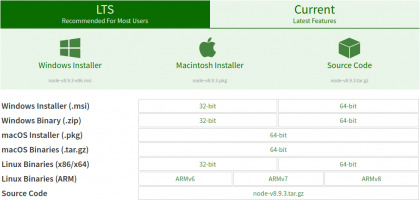申请了阿里云的主机,后续打算将博客转移到阿里云上,之前的腾讯云由于没有备案都闲置了,用作测试。
顺便从头记录node学习相关。
先安装一个node环境,到node官网下载node安装包
https://nodejs.org/zh-cn/download/
https://nodejs.org/dist/v8.9.3/node-v8.9.3-linux-x64.tar.xz
由于是新的环境,一切都是新的。
首先cd到/temp下,wget https://nodejs.org/dist/v8.9.3/node-v8.9.3-linux-x64.tar.xz
然后解压node-v8.9.3-linux-x64.tar.xz文件(默认使用的root用户,非root用户命令前加sudo)。
tar xvf node-v8.9.3-linux-x64.tar.xz mv node-v8.9.3-linux-x64 node cp -R node /usr/local
将node-v8.9.3-linux-x64重新命名为node
再把node复制到/usr/local下。
之后配置环境变量,由于没有安装vim,先使用vi来编辑,
vi /etc/profile
在/etc/profile下追加node环境配置
export NODE_HOME=/usr/local/node export PATH=$NODE_HOME/bin:$PATH export NODE_PATH=$NODE_HOME/lib/node_modules:$PATH
然后按esc之后输入:wq(保存并退出)
让配置生效source /etc/profile
这样安装完成。可以使用node -v查看node版本,可以使用npm -v查看npm版本
安装cnpm或者换源。
如果在centos下(ubuntu也是类似,只是命令不一样)要编译安装node
首先
yum -y install gcc make gcc-c++ openssl-devel wget
下载源码
wget https://nodejs.org/dist/v8.9.3/node-v8.9.3.tar.gz
解压
tar -zxvf node-v8.9.3-linux-x64.tar.gz
编译安装
./configure
make && make install
然后验证
node -v
安装pm2
https://github.com/Unitech/pm2
# General $ npm install pm2 -g # Install PM2 $ pm2 start app.js # Start, Daemonize and auto-restart application (Node) $ pm2 start app.py # Start, Daemonize and auto-restart application (Python) $ pm2 start npm -- start # Start, Daemonize and auto-restart Node application # Cluster Mode (Node.js only) $ pm2 start app.js -i 4 # Start 4 instances of application in cluster mode # it will load balance network queries to each app $ pm2 reload all # Zero Second Downtime Reload $ pm2 scale [app-name] 10 # Scale Cluster app to 10 process # Process Monitoring $ pm2 list # List all processes started with PM2 $ pm2 monit # Display memory and cpu usage of each app $ pm2 show [app-name] # Show all information about application # Log management $ pm2 logs # Display logs of all apps $ pm2 logs [app-name] # Display logs for a specific app $ pm2 logs --json # Logs in JSON format $ pm2 flush $ pm2 reloadLogs # Process State Management $ pm2 start app.js --name="api" # Start application and name it "api" $ pm2 start app.js -- -a 34 # Start app and pass option "-a 34" as argument $ pm2 start app.js --watch # Restart application on file change $ pm2 start script.sh # Start bash script $ pm2 start app.json # Start all applications declared in app.json $ pm2 reset [app-name] # Reset all counters $ pm2 stop all # Stop all apps $ pm2 stop 0 # Stop process with id 0 $ pm2 restart all # Restart all apps $ pm2 gracefulReload all # Gracefully reload all apps in cluster mode $ pm2 delete all # Kill and delete all apps $ pm2 delete 0 # Delete app with id 0 # Startup/Boot management $ pm2 startup # Detect init system, generate and configure pm2 boot on startup $ pm2 save # Save current process list $ pm2 resurrect # Restore previously saved processes $ pm2 unstartup # Disable and remove startup system $ pm2 update # Save processes, kill PM2 and restore processes $ pm2 generate # Generate a sample json configuration file # Deployment $ pm2 deploy app.json prod setup # Setup "prod" remote server $ pm2 deploy app.json prod # Update "prod" remote server $ pm2 deploy app.json prod revert 2 # Revert "prod" remote server by 2 # Module system $ pm2 module:generate [name] # Generate sample module with name [name] $ pm2 install pm2-logrotate # Install module (here a log rotation system) $ pm2 uninstall pm2-logrotate # Uninstall module $ pm2 publish # Increment version, git push and npm publish





